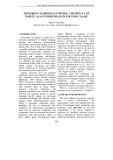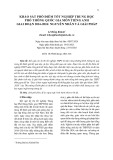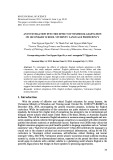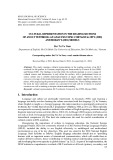
comparison the discovery of similarities between two or more items or ideas
complex sentence a sentence with at least one dependent and one independent clause
compound sentence a sentence with at least two independent clauses
conclusion in critical reasoning, the main claim of an argument (the assertion it aims to prove)
conjunctive adverb a word or phrase that often works with a semicolon to connect two independent clauses
and show the relationship to one another (e.g., however, therefore, likewise)
contraction a word that uses an apostrophe to show that a letter or letters have been omitted (e.g., can’t)
contrast the discovery of differences between two or more items or ideas
coordinating conjunction one of seven words
—
and, but, for, nor, or, so, and yet
—
that serve to connect two
independent clauses
dependent clause a clause that has a subordinating conjunction and expresses an incomplete thought
diction word choice
direct object the person or thing that receives the action of the sentence
effect an event or change created by an action
fragment an incomplete sentence (it may or may not have a subject and predicate)
gerund the noun form of a verb, which is created by adding -ing to the verb base
helping verb (auxiliary verb) verbs that help indicate exactly when an action will take place, is taking place,
did take place, should take place, might take place, and so on.
independent clause a clause that expresses a complete thought and can stand on its own
indirect object the person or thing that receives the direct object
infinitive the base form of a verb plus the word to (e.g., to go)
intransitive verb a verb that does not take an object (the subject performs the action on his-/her-/itself)
logical reasonable, based upon reasoning and good common sense, not emotional
logical fallacy a flaw or error in reasoning
main idea the controlling idea of a passage
mechanics the rules governing punctuation, capitalization, and spelling
modifier a word or phrase that describes or qualifies a person, place, thing, or action
non sequitur a logical fallacy in which the connection between a premise and conclusion is unstated; jump-
ing to conclusions
order of importance when ideas are arranged by rank, from most to least important or least to most
important
paragraph one or more sentences about one main idea, set off by indenting the first line
participial phrase the adjective form of a verb, which is created by adding -ing to the verb base
passive voice when the subject of the sentence is being acted upon (passively receives the action)
past participle the verb form expressing what happened in the past, formed by a past-tense helping verb
plus the simple past-tense form of the verb
phrase a group of words that do not contain both a subject and a predicate (e.g., in the box,will be going)
post hoc, ergo propter hoc a logical fallacy that assumes X caused Y just because X preceded Y
predicate the part of the sentence that tells us what the subject is or does
premise a claim given in support of a conclusion in an argument
–VERBAL SECTION GLOSSARY–
208

present participle the verb form expressing what is happening now, which is formed by a present-tense
helping verb and -ing form of the main verb
proper noun a noun that identifies a specific person, place, or thing (e.g., Elm Street)
qualifier a word or phrase that limits the scope of a claim (e.g., never,always)
red herring a logical fallacy in which the arguer brings in an irrelevant issue to divert the argument
redundancy the unnecessary repetition of words or ideas (e.g., Lana’s mentally out of her mind!)
run-on a sentence that has two or more independent clauses without the proper punctuation or connect-
ing words (e.g., subordinating conjunction) between them
slippery slope a logical fallacy that presents an if/then situation as an absolute
straw man a logical fallacy in which the opponent’s position is distorted, oversimplified, exaggerated, or
otherwise misrepresented
style the manner in which something is done; in writing, the combination of a writer’s sentence structure
and word choice
subject the person, place, or thing that performs the action of the sentence
subjunctive the verb form that indicates something that is wished for or contrary to fact
subordinating conjunction a word or phrase that introduces an adverb clause, making the clause depend-
ent and showing its relationship to another (usually independent) clause (e.g., because, since, while)
superlative the adjective form showing the greatest degree in quality or quantity, which is formed by adding
-est (e.g., happiest), most (e.g., most boring), or least
thesis the main idea or theme of a passage
tone the mood or attitude conveyed by words or speech
topic sentence a sentence that expresses the main idea of a paragraph
transition a word or phrase used to move from one idea to the next and show the relationship between
those ideas (e.g., however, next, in contrast)
transitive verb a verb that takes an object (someone or something receives the action of the verb)
wordiness the use of several words when a few words can more clearly and concisely express the same idea
(e.g., the pen that belongs to Jill)
–VERBAL SECTION GLOSSARY–
209


III
PART The GMAT
Analytical
Writing
Assessment














![Từ vựng tiếng Anh về thức ăn và giảm cân [mới nhất, đầy đủ]](https://cdn.tailieu.vn/images/document/thumbnail/2025/20251217/nglinh.diamond@gmail.com/135x160/53091766028543.jpg)


![Tài liệu Từ vựng tiếng Anh Trung cấp [mới nhất]](https://cdn.tailieu.vn/images/document/thumbnail/2025/20250913/nguyentuan250421@gmail.com/135x160/99491757910839.jpg)
![Tài liệu Từ vựng Tiếng Anh theo chủ đề [mới nhất]](https://cdn.tailieu.vn/images/document/thumbnail/2025/20250913/namdhuet@gmail.com/135x160/83251757753810.jpg)



![Tài liệu Từ vựng tiếng Anh cho bé [chuẩn nhất/mới nhất]](https://cdn.tailieu.vn/images/document/thumbnail/2025/20250731/huadaithesang2509@gmail.com/135x160/18631754013896.jpg)




